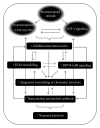Visual cortex plasticity: a complex interplay of genetic and environmental influences
- PMID: 22852098
- PMCID: PMC3407658
- DOI: 10.1155/2012/631965
Visual cortex plasticity: a complex interplay of genetic and environmental influences
Abstract
The central nervous system architecture is highly dynamic and continuously modified by sensory experience through processes of neuronal plasticity. Plasticity is achieved by a complex interplay of environmental influences and physiological mechanisms that ultimately activate intracellular signal transduction pathways regulating gene expression. In addition to the remarkable variety of transcription factors and their combinatorial interaction at specific gene promoters, epigenetic mechanisms that regulate transcription have emerged as conserved processes by which the nervous system accomplishes the induction of plasticity. Experience-dependent changes of DNA methylation patterns and histone posttranslational modifications are, in fact, recruited as targets of plasticity-associated signal transduction mechanisms. Here, we shall concentrate on structural and functional consequences of early sensory deprivation in the visual system and discuss how intracellular signal transduction pathways associated with experience regulate changes of chromatin structure and gene expression patterns that underlie these plastic phenomena. Recent experimental evidence for mechanisms of cross-modal plasticity following congenital or acquired sensory deprivation both in human and animal models will be considered as well. We shall also review different experimental strategies that can be used to achieve the recovery of sensory functions after long-term deprivation in humans.
Figures



Similar articles
-
Human brain plasticity: evidence from sensory deprivation and altered language experience.Prog Brain Res. 2002;138:177-88. doi: 10.1016/S0079-6123(02)38078-6. Prog Brain Res. 2002. PMID: 12432770 Review.
-
Experience Affects Critical Period Plasticity in the Visual Cortex through an Epigenetic Regulation of Histone Post-Translational Modifications.J Neurosci. 2016 Mar 23;36(12):3430-40. doi: 10.1523/JNEUROSCI.1787-15.2016. J Neurosci. 2016. PMID: 27013673 Free PMC article.
-
Cross-modal plasticity for the spatial processing of sounds in visually deprived subjects.Exp Brain Res. 2009 Jan;192(3):343-58. doi: 10.1007/s00221-008-1553-z. Epub 2008 Sep 2. Exp Brain Res. 2009. PMID: 18762928 Review.
-
Serotonin triggers a transient epigenetic mechanism that reinstates adult visual cortex plasticity in rats.Eur J Neurosci. 2011 Jan;33(1):49-57. doi: 10.1111/j.1460-9568.2010.07488.x. Epub 2010 Dec 12. Eur J Neurosci. 2011. PMID: 21156002
-
Regional Specificity of GABAergic Regulation of Cross-Modal Plasticity in Mouse Visual Cortex after Unilateral Enucleation.J Neurosci. 2015 Aug 12;35(32):11174-89. doi: 10.1523/JNEUROSCI.3808-14.2015. J Neurosci. 2015. PMID: 26269628 Free PMC article.
Cited by
-
Calibrating Vision: Concepts and Questions.Vision Res. 2022 Dec;201:108131. doi: 10.1016/j.visres.2022.108131. Epub 2022 Oct 28. Vision Res. 2022. PMID: 37139435 Free PMC article. Review.
-
Multisensory integration, brain plasticity and optogenetics in visual rehabilitation.Front Neurol. 2025 Jul 10;16:1590305. doi: 10.3389/fneur.2025.1590305. eCollection 2025. Front Neurol. 2025. PMID: 40708952 Free PMC article. Review.
-
Fractality of sensations and the brain health: the theory linking neurodegenerative disorder with distortion of spatial and temporal scale-invariance and fractal complexity of the visible world.Front Aging Neurosci. 2015 Jul 15;7:135. doi: 10.3389/fnagi.2015.00135. eCollection 2015. Front Aging Neurosci. 2015. PMID: 26236232 Free PMC article.
-
Activity-dependent NPAS4 expression and the regulation of gene programs underlying plasticity in the central nervous system.Neural Plast. 2013;2013:683909. doi: 10.1155/2013/683909. Epub 2013 Aug 18. Neural Plast. 2013. PMID: 24024041 Free PMC article. Review.
-
Comparative Neuroplasticity in Frontal- and Lateral-Eyed Mammals With Induced-Binocular Vision Dysfunction: Insights From Monocular Deprivation Models.Eur J Neurosci. 2025 Jul;62(1):e70179. doi: 10.1111/ejn.70179. Eur J Neurosci. 2025. PMID: 40634238 Free PMC article. Review.
References
-
- Katz LC, Shatz CJ. Synaptic activity and the construction of cortical circuits. Science. 1996;274(5290):1133–1138. - PubMed
-
- Berardi N, Pizzorusso T, Maffei L. Critical periods during sensory development. Current Opinion in Neurobiology. 2000;10(1):138–145. - PubMed
-
- Kasamatsu T, Pettigrew JD. Depletion of brain catecholamines. Failure of ocular dominance shift after monocular occlusion in kittens. Science. 1976;194(4261):206–209. - PubMed
-
- Bear MF, Singer W. Modulation of visual cortical plasticity by acetylcholine and noradrenaline. Nature. 1986;320(6058):172–176. - PubMed
-
- Gu Q, Singer W. Effects of intracortical infusion of anticholinergic drugs on neuronal plasticity in kitten striate cortex. European Journal of Neuroscience. 1993;5(5):475–485. - PubMed
Publication types
MeSH terms
Substances
LinkOut - more resources
Full Text Sources

